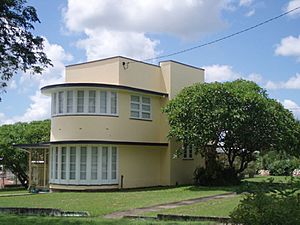Amla, Rockhampton facts for kids
Quick facts for kids Amla |
|
|---|---|

Amla, 2009
|
|
| Location | 49 Jessie Street, The Range, Rockhampton, Rockhampton Region, Queensland, Australia |
| Design period | 1940s - 1960s (post-World War II) |
| Built | 1952 |
| Architect | Arthur Edward Hegvold |
| Architectural style(s) | Functionalism |
| Official name: Amla | |
| Type | state heritage (landscape, built) |
| Designated | 28 July 2000 |
| Reference no. | 601593 |
| Significant period | 1950s (fabric) |
| Significant components | furniture/fittings, garden/grounds, residential accommodation - main house |
| Builders | Robert Leonard Schofield |
| Lua error in Module:Location_map at line 420: attempt to index field 'wikibase' (a nil value). | |
Amla is a special house in The Range, Rockhampton, Queensland, Australia. It's a detached house, meaning it stands on its own. The house was designed by a famous Rockhampton architect named Edward Arthur Hegvold. It was built in 1952 by Robert Leonard Schofield. Amla is so important that it was added to the Queensland Heritage Register on 28 July 2000. This means it's protected because of its historical and architectural value.
Contents
Amla's Story
Amla is a two-story house built in a style called Functionalist style. This style focuses on how useful a building is, with simple, clean designs.
How Amla Was Built
The land for Amla was bought in 1951 by Norman and Victoria Nell Ellemor. Norman Ellemor was a manager for a company called Thos Brown in Rockhampton. The house was finished in 1952. At this time, it was easier to build houses after World War II. In 1953, the Ellemors moved away, and the current owners bought the house. The house's first address was Brecknell Street. The land next to it, on Jessie Street, was added in 1969.
The Architect: E. A. Hegvold
Edward Arthur Hegvold was born in Rockhampton in 1909. He started learning about architecture in 1924. He worked for another architect, Roy Chipps, until 1935. During the Great Depression, Hegvold and Chipps even designed advertisements.
Hegvold opened his own architecture business in 1938. During World War II, he worked for the US Army in Rockhampton. He designed many buildings for the army, like aircraft hangars and warehouses. This work made him very interested in how buildings are put together. After the war, he reopened his business. He was a leading architect in Rockhampton from the 1950s to the 1970s. He designed many important buildings not just in Rockhampton, but all over central Queensland.
Hegvold's Famous Buildings
Some of the buildings Hegvold designed in Rockhampton include:
- The Rockhampton Electricity Board building
- The RACQ Building
- Tobruk House
- The World War 2 Memorial Pool
He also designed buildings in other towns, such as:
- The North Gregory Hotel in Winton
- Fire stations in Longreach and Emerald
- Town halls in Alpha and Jericho
Hegvold was also a well-known person in his community. He helped many local clubs and charities. The Rockhampton Basketball Stadium is even named after him! He passed away in Rockhampton in 1991.
What Amla Looks Like
Amla is a two-story house that looks like a cube. It's made of timber and covered with textured cement. The roof is flat and hidden by the walls around it. The outside of the house has a mix of horizontal and vertical lines.
Design Features
The main entrance and stairway stick out, making a vertical shape. The windows have continuous hoods that provide shade. These hoods create strong horizontal lines.
Amla is a great example of the Interwar Functionalist style, even though it was built after World War Two. This style uses plain surfaces and simple shapes. The design is not perfectly balanced, which is typical for this style. The house has rounded corners and flat rooflines. The sunshade hoods wrap around these corners.
The garden around the house is simple and fits well with the nearby homes.
Inside Amla
Inside, the house is planned very cleverly to use space well. Even though it's compact, the rooms feel spacious. The Functionalist style continues inside with features like the open staircase. It has solid railings with polished wood and decorative chrome details.
Why Amla is Special
Amla was added to the Queensland Heritage Register on 28 July 2000. This means it's recognized as an important part of Queensland's history and culture.
A Part of History
Amla shows how Rockhampton developed after World War II. It's a good example of the buildings from that time.
A Unique Style
Amla is a very good example of a house built in the Interwar Functionalist style. This style is quite rare in Rockhampton, which makes Amla even more special.
Showing Key Features
Amla clearly shows the main features of the Interwar Functionalist style. These include:
- Its cube-like shape
- Hidden flat roof
- Smooth, painted outside walls
- Windows arranged in both vertical and horizontal patterns
- Cantilevered (sticking out) hoods over the windows
It's also a great example of the work of architect E. A. Hegvold. He played a big role in shaping the look of Rockhampton and central Queensland after World War Two.

